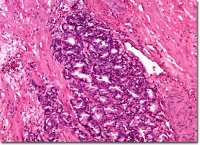header needs to be changed - DEFAULT

What diagnoses does the pathologist make?
Prostate cancer is a subjective and often very subtle diagnosis. For this reason, in all cases we review outside biopsy material in-house. This is a simple quality control measure. In addition, in particularly challenging cases, we send the biopsy material to Bostwick Laboratories, a national prostate cancer reference laboratory.
In all cases, the pathologist looks for cancer. While we generally expect that most will be adenocarcinoma of the prostate (see previous question), the pathologist will also look for other types of prostate cancer; these are very rarely found.
In addition to prostate cancer, the pathologist looks for a number of conditions of the prostate. Among the most common is benign prostate hyperplasia, a loss of cell volume known as atrophy, inflammation, atypical small acinar proliferation (ASAP), and prostatic intraepithelial neoplasia (PIN). The latter two conditions, when seen in the absence of cancer, imply that a future prostate biopsy will show prostate cancer.
When there is prostate cancer, the pathologist also looks for perineural invasion (PNI), wherein the prostate cancer associates with intra-prostatic nerves (not the external neurovascular bundles for erections). Perineural invasion seen on a prostate biopsy implies a risk of higher prostate cancer stage.
In the case of prostate cancer, the report should indicate the prostate cancer grade and proportion of tissue that is prostate cancer.
Notice: Undefined variable: prev in /home/eb4nhwo80k78/public_html/classes/site.php on line 697


